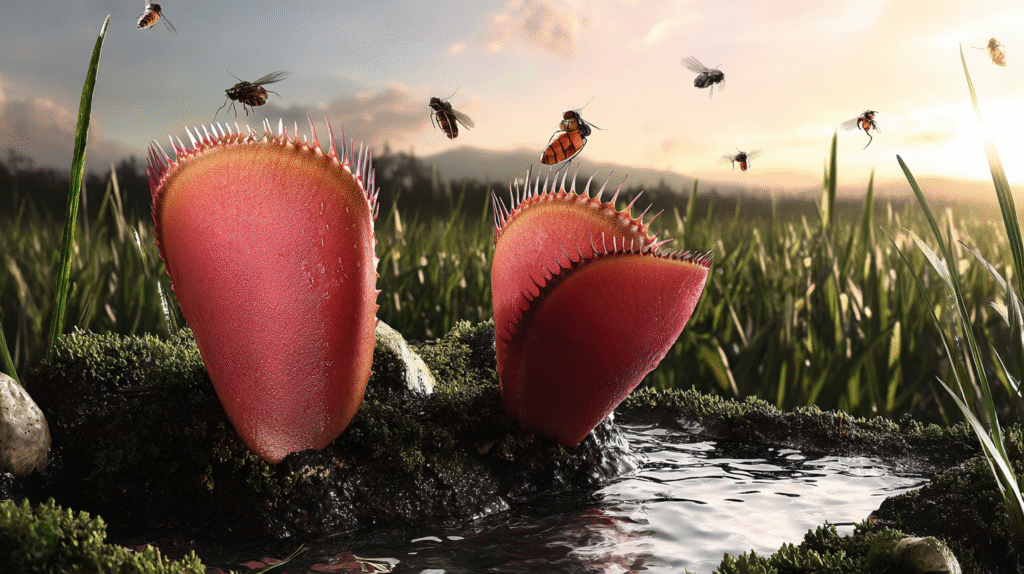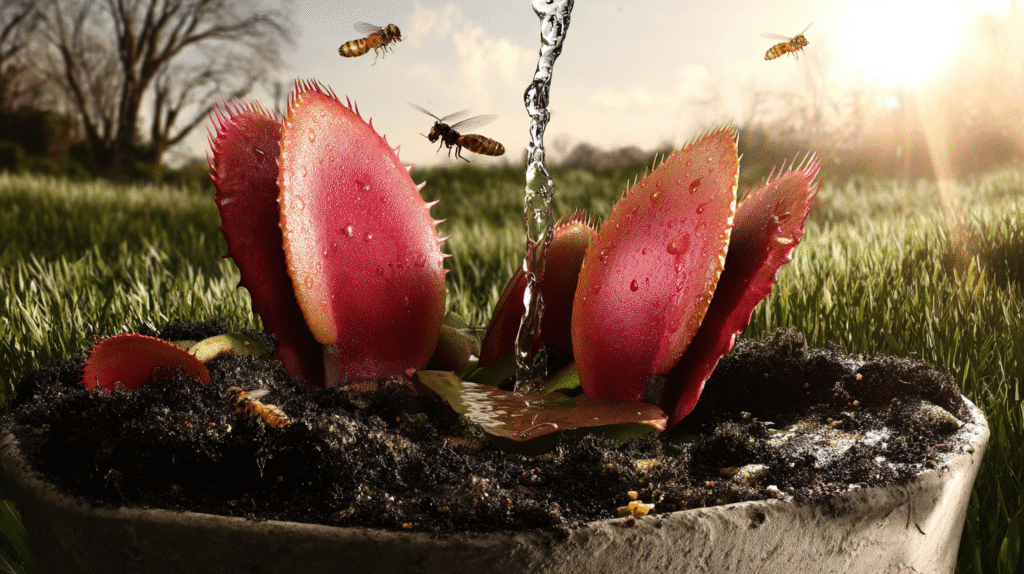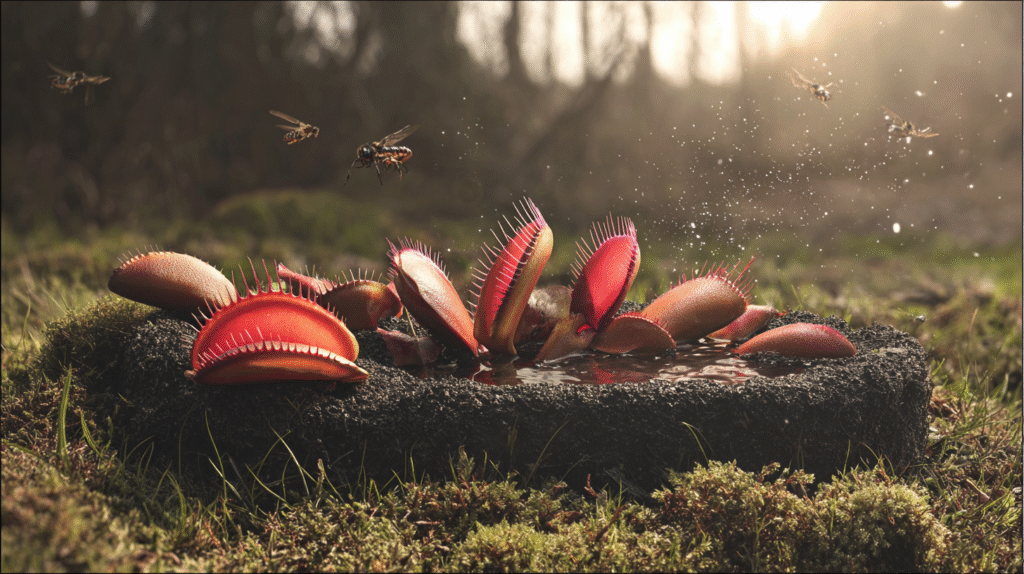My Venus flytrap graveyard was getting embarrassing. Six dead plants in one year, each dying a different horrible death. Black traps, mushy crowns, mysterious overnight collapses — I was basically running a carnivorous plant hospice.
The worst part? I’d successfully grown orchids, kept finicky calatheas alive, even managed to propagate that impossible Pink Princess philodendron. But these supposedly “easy” flytraps from the hardware store? Dead within weeks, every single time.
Then I joined a carnivorous plant forum out of desperation and discovered I’d been doing literally everything wrong. Turns out Venus flytraps don’t want to be treated like houseplants — they want to be treated like the bog-dwelling, winter-hibernating weirdos they are. Two years later, I have five thriving flytraps that actually catch flies, and one just bloomed for the first time.
The Murders That Made Me Learn
Let me detail my failures because they’re probably yours too:
Death by Tap Water: Killed three plants before learning they need pure water. Our tap water? Might as well be poison to them.
Death by Potting Soil: “It’s a plant, right?” Wrong. Regular soil kills them faster than forgetting to water.
Death by Indoor Living: Kept them inside like houseplants. They slowly weakened and died, probably dreaming of sunshine.
Death by Terrarium: Thought enclosed humidity would help. Created a fungal nightmare instead.
Death by Feeding: Force-fed them dead flies thinking I was helping. Turns out I was exhausting them to death.
Death by “Rescuing” from Dormancy: Thought my first successful one was dying when it went dormant. Brought it inside to “save” it. Actually killed it.

The Water Revelation That Changed Everything
This is where 90% of people (including past me) fail immediately. Venus flytraps are prima donnas about water.
What kills them:
- Tap water (minerals are toxic)
- Well water (usually too hard)
- Bottled spring water (has minerals)
- “Purified” water (often just filtered)
What they actually need:
- Distilled water
- Reverse osmosis water
- Rainwater (if you’re not near pollution)
- TDS meter reading under 50ppm
I now buy distilled water by the gallon. Yes, it’s annoying. Yes, it costs about $1 per gallon. But it’s cheaper than replacing dead plants every month.
The tray method: Keep them sitting in 1 inch of water at all times. Sounds like root rot waiting to happen, but they’re bog plants. They love wet feet.
Light: Why “Bright Window” Isn’t Enough
Every care tag says “bright light.” What they mean is “full blazing sun or they’ll slowly die.”
Where mine failed:
- East window: Not enough, slow decline
- “Bright” indoor spot: Stretched and weakened
- Under regular LED: Survived but never thrived
Where they exploded with growth:
- Outside in full sun (6+ hours direct)
- South-facing window touching glass
- Under grow lights 14 hours daily
My healthiest flytrap sits outside from March to November. It’s deep red, compact, and catches bugs constantly. The same variety kept indoors stays green and grows maybe two traps a year.

The Soil Situation Nobody Explains Properly
Hardware store flytraps come in mystery soil that’s usually wrong. Here’s what actually works:
The only acceptable mixes:
- 50/50 peat moss and perlite
- 50/50 peat moss and sand (not beach sand!)
- Pure long-fiber sphagnum moss
What kills them:
- Regular potting soil (nutrients burn roots)
- Compost (they’ll die immediately)
- Miracle-Gro anything (fertilizer = death)
- Cactus mix (still has nutrients)
I killed a beautiful red dragon variety by repotting in “carnivorous plant soil” from a big box store. Turns out it was just peat with fertilizer added. Dead in two weeks.
The Feeding Fiasco
This is where people get weird. You don’t need to feed Venus flytraps. They’re photosynthetic plants that happen to supplement with bugs.
What I learned:
- They catch their own food outside
- Indoor plants can go months without eating
- One bug per month is plenty
- Overfeeding exhausts them
- Trigger traps sparingly (limited energy)
The hamburger myth: Never feed them meat. I tried this once. The trap turned black and rotted. They need live insects or recently dead ones with bug juice intact.
My outdoor plants catch plenty. Indoor ones get a small fly maybe monthly. They’re all thriving.
Dormancy: The “Death” That Isn’t
This almost made me quit. My first surviving flytrap started “dying” in fall — black leaves, no new growth, looked terrible. I panicked and brought it inside to warm up. Actual death followed.
What dormancy looks like:
- Growth slows in fall
- Leaves turn black and die back
- Plant shrinks to almost nothing
- Looks completely dead
- This is NORMAL
Dormancy requirements:
- 3-4 months of cold (35-50°F)
- Reduced light is fine
- Keep soil barely moist
- Don’t feed during this time
Now I put them in my unheated garage near a window. They look dead all winter, then explode with growth in spring. Skipping dormancy = slow death over 1-2 years.
My Current Setup That Actually Works
Outdoor growing season (March-November):
- Full sun location
- Sitting in distilled water trays
- No feeding needed
- Rain is fine (free distilled water!)
Winter dormancy (December-February):
- Unheated garage near window
- Check water monthly
- Ignore them mostly
- Look terrible but they’re fine
For apartment dwellers:
- Grow lights are mandatory
- Distilled water still required
- Fridge dormancy works (Google it)
- Prepare for more maintenance
Common Problems I’ve Solved
Black traps:
- Usually normal if just the trap
- If spreading to crown: fungal issue
- If after feeding: food too big
Not closing on prey:
- Each trap only works 3-5 times
- Old traps stop functioning
- Don’t trigger for fun
Flowering:
- Cut flower stalks unless you want seeds
- Flowering exhausts them
- My first bloomer almost died
Algae in water trays:
- Normal but ugly
- Change water weekly
- Or add mosquito dunks

The Mindset Shift Required
Stop thinking of Venus flytraps as houseplants. They’re more like:
- Bog orchids that eat bugs
- Outdoor perennials that need winter
- Water garden plants that happen to be carnivorous
Once I stopped trying to make them fit my houseplant routine and started meeting their weird needs, everything clicked.
Why I Keep Growing These Weirdos
They’re not easy. They’re not convenient. They require special water, specific soil, and demand seasons. So why do I have five?
Because watching a Venus flytrap snap shut on a fly never gets old. Because they’re living proof that plants evolved insane solutions to nutrient-poor environments. Because successfully growing something this particular feels like an achievement.
My friend’s kid thinks I’m the coolest adult ever because I grow “monster plants.” My flytraps have converted three people to carnivorous plant growing. There’s something magical about a plant that moves and eats.
The Bottom Line on Venus Flytraps
They’re not starter plants. They’re not houseplants. They’re fascinating weirdos with specific needs that will die if you treat them like normal plants.
But if you can commit to:
- Distilled water only
- Full sun or grow lights
- Proper soil
- Winter dormancy
- Not playing with traps
You’ll have an incredible plant that moves, eats, and amazes everyone who sees it. Just don’t start with those death cubes from chain stores. Find a reputable carnivorous plant nursery, get a healthy plant, and prepare to become obsessed.
My Venus flytrap journey went from serial killer to successful grower. If I can do it after six murders, you can too. Just remember: they’re not trying to be difficult — they’re just extremely specialized bog plants pretending to be pets. Treat them like the weirdos they are, and they’ll thrive. 🪴






